

 |
Cherokee County, IA |
 |
|
|
||
| Cherokee
County Historic Sites
|
|---|
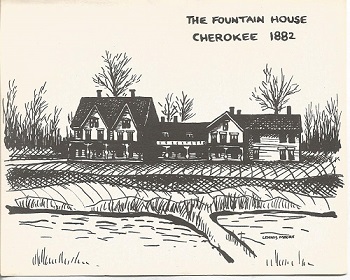 Click to enlarge images |
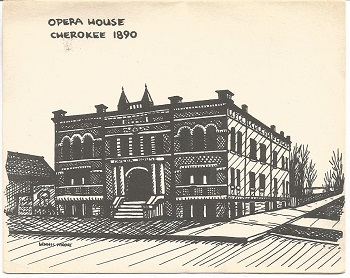 Click to enlarge images |
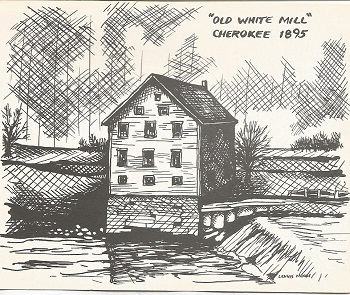 Click to enlarge images |
|
| Fort
Cherokee 1863
In 1861, the State government created the Iowa Border Brigade to protect the frontier. Cherokee was chosen as the site for a Blockhouse and Fort. In 1862, a Fort was constructed near the present site of the city of Cherokee. Fort Cherokee was garrisoned by a Lieutenant and Ste troops. In 1863, the settlement was again abandoned - only the troops at the Fort and Carlton Corbett, the county treasurer, remaining in the county. The last Indian battle, in which a participant was killed in Iowa, was fought in Cherokee County, in August of 1862, Sam and Andrew Purcell, scouts for the Border Brigade, shot and killed a Sioux warrior and wounded another during a horse-stealing raid. Fort Cherokee was abandoned in 1864, and later dismantled. Author:
Geo K. Pettengill
|
The
Fountain House Cherokee 1882 While
prospecting for coal in 1880, a spring of mineral magnetic waters was
discovered near the city of Cherokee. The water was proven, because of
it's magical magnetic forces, to be beneficial to the human health
system.
George Satterlee owned the land where this well was made. He offered baths & water from the mineral spring water. Soon, N.T. Burroughs, of the First National Bank of Cherokee, bought three quarters of George's interest and at once platted an annex to the city, the same being known as "Magnetic Addition." Here he erected a three story sanitarium resort & spa known as the Fountain House. It was a good sized structure which was open to the public. Nearby, an area was flooded with water from the spring and became known as "Magnetic Lake". Dr.
Goddard Gee of Chicago eventually leased the site and treated hundreds
of patients successfully. After Dr. Gee left, the place was closed for
a number of years due to the travel requirements of Mr. Burroughs. It
was reopened in 1889.
In 1915 Burroughs sold the property to Geo. S. Jones who converted some buildings for dairy and tore down others. In 1928 John Ogilvy purchased a portion of the property that contained the remaining buildings. He used the Fountain House for apartments for awhile then the building was removed. John salvaged lumber from the Fountain House to build a dairy barn (1929) & his home (1933). The former Magnetic Lake now stands as a pond but is disconnected from the spring. Sources: History of Cherokee County, Iowa by Thomas McCullough and Cherokee Trails Committee, Cherokee, IA |
Opera
House Cherokee 1890 In
July 1889, a roller rink that doubled as Cherokee's opera house, burned
to the ground. Before the month ended, plans for a new Opera House
building were finalized.
The $20,000 Opera House to Be Erected – The Site Purchased and Plans Being Made. There should be universal satisfaction and delight among our people over the fact that definite arrangements have been made for the building of a first class opera house in the city. After hard rustling on the part of a few, twenty-six of our citizens have been induced to take stock in the company. After much deliberation a site was selected which will meet the approval of most of our citizens. It is the old Times office site, opposite the Washington house, the best for the purpose in the city. ( Located at the corners of Maple & Second Streets) The building is to be vacated in a very few days. The Opera House Company will move it to the east side of the lot and lease it to the school board if desired. The opera house will be of brick and cover a space 60 x 100 feet. It will have a basement the full size for holding festivals, fairs and the like, and will be fitted up with kitchens, cloak room, etc., making it a fine place for the purposes intended. The interior of the opera house will be of modern architectural design, with parquet dress circle, balcony and boxes. The cost of the whole, including site, will reach $20,000. It will have a seating capacity of 600 and the scenery and stage fixtures will be all that can be desired. Work will begin as soon as someone can be secured to move the old building. Source: The Weekly Cherokean_Democrat July 31, 1889 Click here to see the Opera House History continued below |
The
Old White Mill Cherokee 1895 Of the
flouring mill industry it may be remarked that the early
settlers in some cases had to resort to the use of the family coffee
mills in order to get a baking of bread or biscuit; at other times they
had to go to mill to such points as Fort Dodge, Sioux City, Mankato,
Minnesota and even Council Bluffs, the distance to Mankato being about
one hundred and fifty miles.
In
the fall of 1871 J.B. Bliss
completed his water power flouring mill, styled the Cherokee Mills and
from it he sold his first load of flour November 17 of that year. This
was a three-story frame mill 40x46 feet, situated on the west bank of
the Little Sioux river, at a point where the wagon bridge
spanned
by
an iron bridge, just to the northeast of the business portion of the
city. A seven foot head of water was obtained by damming the river. At
first the old fashioned millstones were used for grinding. The system
was changed in 1887, by Charles Beckwith, who purchased the mill in
1882, to a full roller system”, with a daily capacity of fifty barrels
of flour. It was a custom mill and all surplus flour and feed found a
ready sale within the city and adjoining villages and towns of Cherokee
county.
|
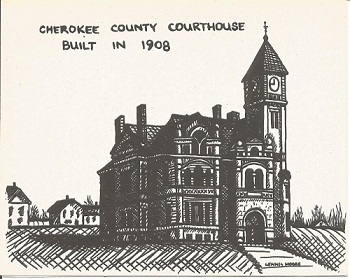 Click to enlarge images |
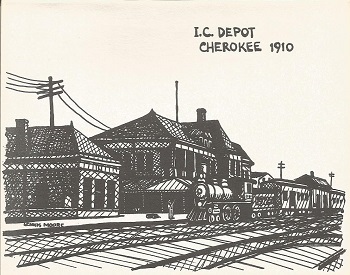 Click to enlarge images |
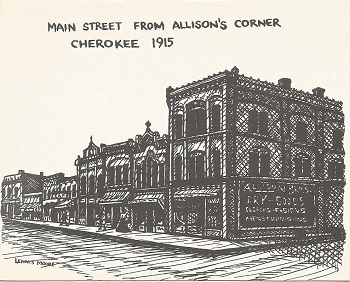 Click to enlarge images |
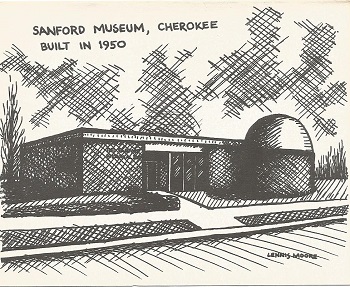 Click to enlarge images |
|
By
February 1890 the new Opera House was open for business.
The
following are excerpts from The Weekly Cherokean-Democrat, Feb 12, 1890
regarding the grand opening.: "The management of Cherokee’s
new and elegant play house
announce the grand opening to take place on Monday evening, Feb 24 on
which
occasion Miss Agnes Herndon will appear in her new and great play, “La
Belle
Marie”. It is fitting that so magnificent a theater should be dedicated
by so
superbly fine an actress as Agnes Herndon and the managers are to be
congratulated upon securing so great an attraction. The sale of seats opened at
Schuster & Bechman’s this
morning. The prices range from $2 to $5 so that everybody can afford to
go. The opera house hall will be
dedicated on the evening of the
21st, when the firemen will give their fifth
annual ball. A
good many people – judging from the talk one hears – think
they are too “hard up” to buy tickets for the opening night. Others
seem to
think the prices too high, and propose to stay at home and wait to get
their
amusement at regular prices. Well, times are pretty hard, and it is
unfortunate
for the men who hae invested their money in this great enterprise that
they
have done so at a time when people are feeling so poor although
the more
credit is due them for doing so. There are a good many people who, had
they
been asked, would have subscribed liberally a year ago to raise a bonus
to
secure a good opera house, who now feel that it is too much for them to
buy two
or three tickets.
We venture the assertion there is not a man in Cherokee who will say this opera house is not a grand good thing for the town and a credit to it. Then let us show our appreciation of the spirit of enterprise that gave it to us, or forever hold our peace about ever endeavoring to build up a city. Mark the prediction: IF THIS ENTERPRISE IS NOT ENCOURAGED, CHEROKEE, IN A VERY SHORT TIME, WILL BE TOO DEAD TO SKIN. We
believe it just as much as we believe that we will have to borrow an X
to pay
for our tickets. The man who wouldn't’t buy a sack of flour on time and
sell it
for ash to get into this opera house on the opening night is an
unworthy
citizen of Cherokee."
The Curtain Raised The following excerpts from The Weekly Cherokean - Democrat, Feb 26, 1890 describe opening night: "Well, it is all over. The doors have been opened, the curtain raised and the Grand opera house - grand in all things - has been seen in all its magnificence. Cherokee people have one thing to boast of: they have a finer opera house than any town of the size in the United States - finer in many respects than any opera house in the state of Iowa, outside of Sioux City. The house was not as full on Monday night as enthusiasts would like to have seen but after all the managers are satisfied , considering the terribly stringent times. The Cherokee orchestra covered themselves all over with glory. It was their first attempt at opera house music and they surprised Cherokee people as well as outsiders." The Opera House operated until after WWI at which time it became the Rialto Theatre. Later, it became the Grand Theatre. It burned in 1939. In 1940 the Arrow Theatre was erected on the former Opera House site. Additional sources: cinematreasures.org |
Old White Mill history continued from
above... This mill was operated under several different managements until it finally, and for a second time, came into the possession of P.F. Fassler, who operated it successfully for a number of years, but finding that the water power was not sufficient at all times of the year and the flood of 1891 taking out the dam, he erected in 1892 the present steam flouring mills of this city and the “Old White Mill,” which had been of inestimable service to the people of this city and county was abandoned. The dam was swept away during the great flood of 1891 but the mill itself withstood the flood, though the waters rushed through it almost to the second floor. The mill finally passed into the possession of Nathan Phipps and later was torn down, thus removing a prominent land mark of Cherokee. Forsaking
The Dam
Tearing Down The Old Mill and Building the New "On Wednesday morning, Sep 19, 1900, Phil Fassler began the work of tearing down the old white mill and building up the new one in north part of town. A force of men were put at work tearing down the mill and Mr. Fassler figured that he would have it all hauled to the new location within ten or twelve days. Most of the old structure is in good condition, especially the heavy inside timbers, and can be used in the new structure. A force of men and teams were also put at work making the excavation for the new mill, and the work is to be pushed as rapidly as possible. The new structure will be practically four stories in height. Rock for the basement walls will be taken from the old dam, where there is figured to be about 150 cords. The new mill will be first class in every way and a credit to its proprietor. The estimated cost of the change is $10,000, but will probably exceed that." Sources: History of Cherokee County, Iowa, Vol I by Thomas McCullough The Cherokee Democrat Semi Weekly, Sep 21, 1900 |
||
| These sketches were contributed by the former Cherokee Historical Society. The sketch artist is Lennis Moore. | |||
Return to History Index
Return to Home Page